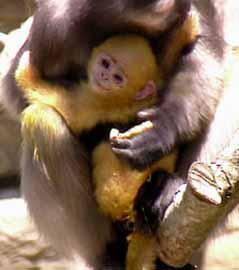The family Cercopithecidae includes 18 genera and 81 species. These monkeys are widely distributed in the Old World from southern Europe (Gibraltar) into NW Africa; throughout Africa south of the Sahara; and through central and SE Asia, including southern China and most of Japan. Some cercopithecids show greater tolerance for cold than any other non-human primates; one macaque inhabits the cold and snowy regions of northern Japan. The earliest records of cercopithecids are from the Oligocene of Egypt. All fossil records are from the Old World, matching the distribution of modern species. Some extinct species were huge; one nearly reached the size (but not the robustness) of a gorilla.
Cercopithecidae
Old World monkeys and baboons, including macaques, rhesus, mangabeys, mandrills, guenons, patas monkeys, langurs, proboscis monkeys, colubus, and many others
Cercopithecids are divided into two ecologically and morphologically distinct subfamilies. The cercopithecines are omnivorous, have cheek pouches, and simple stomachs; while the colobines are folivorous, lack cheek pouches, and have complex stomachs. Cercopithecids are medium to large size, ranging from around 1.5kg to over 50 kg. Many have a stocky build. Their nostrils are close together and face downward, a condition known as catarrhine. The forelimbs generally are shorter than the hindlimbs. All digits have nails; these are flat, not curved as in cebids. The pollex and hallux are opposable except the genus Colobus, in which the pollex is nearly absent. The palms and soles are naked. A tail is present and may be long or vestigial, but it is never fully prehensile as in many cebids. Many cercopithecids have ischial callosities, brightly colored patches of skin on their rumps. These are used in dominance and sexual displays. The facial muscles or cercopithecids are well developed, and facial expressions play an important role in social behavior. The fur of these monkeys is usually gray or brown, but some are brightly marked. The fur is never wooly and rarely silky.
Cranially, cercopithecids have a robust and heavily ridged skull compared to cebids, and the rostrum of some species (baboons) is rather long. The palate is long and concave, extending beyond last molar. The bullae are small but a bony eustachian tube is present (formed from the ectotympanic). The dental formula is 2/2, 1/1, 2/2, 3/3 = 32. The medial incisors are often broad and spoon-shaped; the upper canines are usually large and separated from incisors by a small diastema; the first lower premolar is enlarged and its edge shears against the sharp posterior edge of upper canine; the molars quadrate and bilophodont. On the lower molars, a hypoconulid is present.
Cercopithecids are almost exclusively diurnal. They exhibit a great variety of social behavior. Most can be found in groups of varying size, and interactions among individuals may be complex. The basic unit seems to be a family group, but sometimes much larger bands form. Most cercopithecids are arboreal, but baboons are primarily terrestrial.
Many cercopithecids show pronounced sexual dimorphism. This may be in body size (males are up to twice the weight of females in some species), color, or in the degree of development of the canines.
HOME
Primates
Primate FAQ
Baboon Culture
Primate Species
Baboon Pictures
Mandrill Pictures
Search Primates.com
Snow Monkey Pictures
Primates E-Mail Service
Highland Mangabey Discovery
